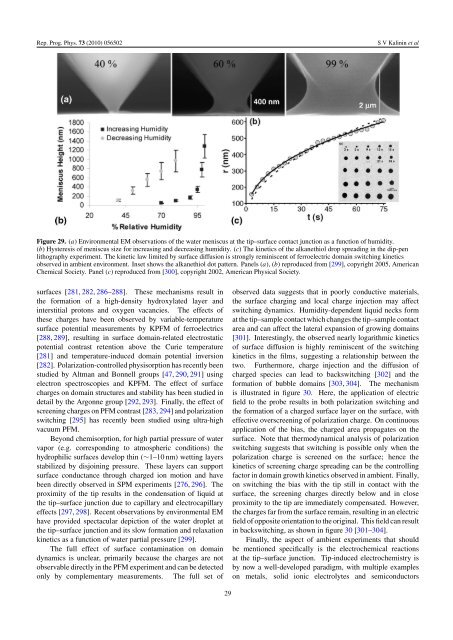Local polarization dynamics in ferroelectric materials
Local polarization dynamics in ferroelectric materials
Local polarization dynamics in ferroelectric materials
You also want an ePaper? Increase the reach of your titles
YUMPU automatically turns print PDFs into web optimized ePapers that Google loves.
Rep. Prog. Phys. 73 (2010) 056502<br />
S V Kal<strong>in</strong><strong>in</strong> et al<br />
Figure 29. (a) Environmental EM observations of the water meniscus at the tip–surface contact junction as a function of humidity.<br />
(b) Hysteresis of meniscus size for <strong>in</strong>creas<strong>in</strong>g and decreas<strong>in</strong>g humidity. (c) The k<strong>in</strong>etics of the alkanethiol drop spread<strong>in</strong>g <strong>in</strong> the dip-pen<br />
lithography experiment. The k<strong>in</strong>etic law limited by surface diffusion is strongly rem<strong>in</strong>iscent of <strong>ferroelectric</strong> doma<strong>in</strong> switch<strong>in</strong>g k<strong>in</strong>etics<br />
observed <strong>in</strong> ambient environment. Inset shows the alkanethiol dot pattern. Panels (a), (b) reproduced from [299], copyright 2005, American<br />
Chemical Society. Panel (c) reproduced from [300], copyright 2002, American Physical Society.<br />
surfaces [281, 282, 286–288]. These mechanisms result <strong>in</strong><br />
the formation of a high-density hydroxylated layer and<br />
<strong>in</strong>terstitial protons and oxygen vacancies. The effects of<br />
these charges have been observed by variable-temperature<br />
surface potential measurements by KPFM of <strong>ferroelectric</strong>s<br />
[288, 289], result<strong>in</strong>g <strong>in</strong> surface doma<strong>in</strong>-related electrostatic<br />
potential contrast retention above the Curie temperature<br />
[281] and temperature-<strong>in</strong>duced doma<strong>in</strong> potential <strong>in</strong>version<br />
[282]. Polarization-controlled physisorption has recently been<br />
studied by Altman and Bonnell groups [47, 290, 291] us<strong>in</strong>g<br />
electron spectroscopies and KPFM. The effect of surface<br />
charges on doma<strong>in</strong> structures and stability has been studied <strong>in</strong><br />
detail by the Argonne group [292, 293]. F<strong>in</strong>ally, the effect of<br />
screen<strong>in</strong>g charges on PFM contrast [283, 294] and <strong>polarization</strong><br />
switch<strong>in</strong>g [295] has recently been studied us<strong>in</strong>g ultra-high<br />
vacuum PFM.<br />
Beyond chemisorption, for high partial pressure of water<br />
vapor (e.g. correspond<strong>in</strong>g to atmospheric conditions) the<br />
hydrophilic surfaces develop th<strong>in</strong> (∼1–10 nm) wett<strong>in</strong>g layers<br />
stabilized by disjo<strong>in</strong><strong>in</strong>g pressure. These layers can support<br />
surface conductance through charged ion motion and have<br />
been directly observed <strong>in</strong> SPM experiments [276, 296]. The<br />
proximity of the tip results <strong>in</strong> the condensation of liquid at<br />
the tip–surface junction due to capillary and electrocapillary<br />
effects [297, 298]. Recent observations by environmental EM<br />
have provided spectacular depiction of the water droplet at<br />
the tip–surface junction and its slow formation and relaxation<br />
k<strong>in</strong>etics as a function of water partial pressure [299].<br />
The full effect of surface contam<strong>in</strong>ation on doma<strong>in</strong><br />
<strong>dynamics</strong> is unclear, primarily because the charges are not<br />
observable directly <strong>in</strong> the PFM experiment and can be detected<br />
only by complementary measurements. The full set of<br />
observed data suggests that <strong>in</strong> poorly conductive <strong>materials</strong>,<br />
the surface charg<strong>in</strong>g and local charge <strong>in</strong>jection may affect<br />
switch<strong>in</strong>g <strong>dynamics</strong>. Humidity-dependent liquid necks form<br />
at the tip–sample contact which changes the tip–sample contact<br />
area and can affect the lateral expansion of grow<strong>in</strong>g doma<strong>in</strong>s<br />
[301]. Interest<strong>in</strong>gly, the observed nearly logarithmic k<strong>in</strong>etics<br />
of surface diffusion is highly rem<strong>in</strong>iscent of the switch<strong>in</strong>g<br />
k<strong>in</strong>etics <strong>in</strong> the films, suggest<strong>in</strong>g a relationship between the<br />
two. Furthermore, charge <strong>in</strong>jection and the diffusion of<br />
charged species can lead to backswitch<strong>in</strong>g [302] and the<br />
formation of bubble doma<strong>in</strong>s [303, 304]. The mechanism<br />
is illustrated <strong>in</strong> figure 30. Here, the application of electric<br />
field to the probe results <strong>in</strong> both <strong>polarization</strong> switch<strong>in</strong>g and<br />
the formation of a charged surface layer on the surface, with<br />
effective overscreen<strong>in</strong>g of <strong>polarization</strong> charge. On cont<strong>in</strong>uous<br />
application of the bias, the charged area propagates on the<br />
surface. Note that thermodynamical analysis of <strong>polarization</strong><br />
switch<strong>in</strong>g suggests that switch<strong>in</strong>g is possible only when the<br />
<strong>polarization</strong> charge is screened on the surface; hence the<br />
k<strong>in</strong>etics of screen<strong>in</strong>g charge spread<strong>in</strong>g can be the controll<strong>in</strong>g<br />
factor <strong>in</strong> doma<strong>in</strong> growth k<strong>in</strong>etics observed <strong>in</strong> ambient. F<strong>in</strong>ally,<br />
on switch<strong>in</strong>g the bias with the tip still <strong>in</strong> contact with the<br />
surface, the screen<strong>in</strong>g charges directly below and <strong>in</strong> close<br />
proximity to the tip are immediately compensated. However,<br />
the charges far from the surface rema<strong>in</strong>, result<strong>in</strong>g <strong>in</strong> an electric<br />
field of opposite orientation to the orig<strong>in</strong>al. This field can result<br />
<strong>in</strong> backswitch<strong>in</strong>g, as shown <strong>in</strong> figure 30 [301–304].<br />
F<strong>in</strong>ally, the aspect of ambient experiments that should<br />
be mentioned specifically is the electrochemical reactions<br />
at the tip–surface junction. Tip-<strong>in</strong>duced electrochemistry is<br />
by now a well-developed paradigm, with multiple examples<br />
on metals, solid ionic electrolytes and semiconductors<br />
29
















